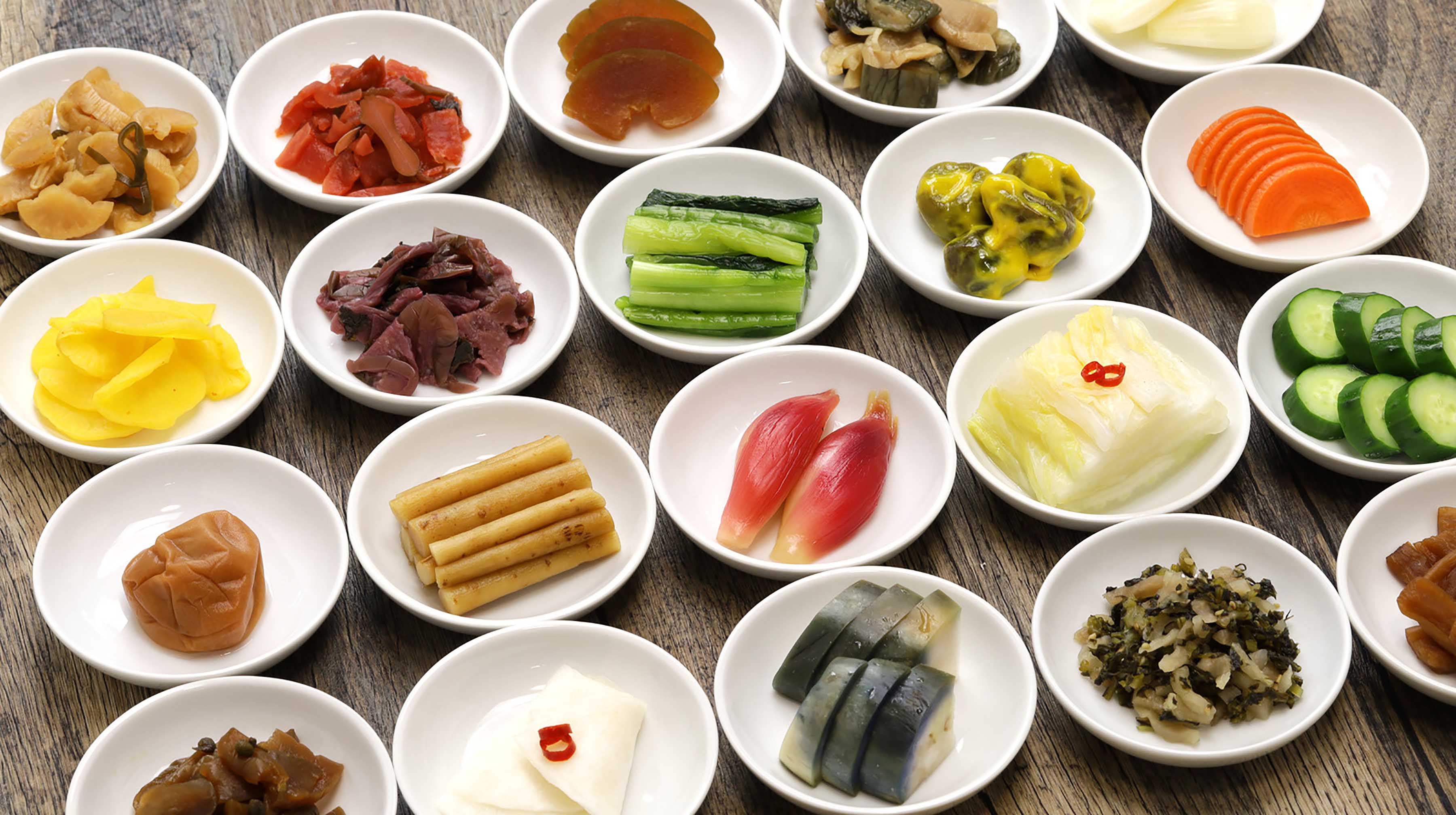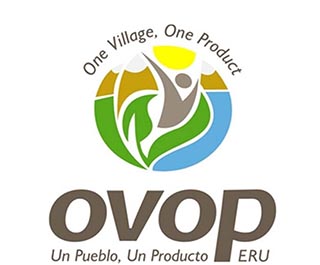Every continent and culture has their own style of pickle. In the United States and Canada there is the classic dill; in Germany there is sauerkraut; in nearby Korea there is kimchi. And while all of these examples in a way represent the culinary culture of those who eat them, it is much harder to pinpoint a particular pickle in Japan. “Tsukemono”, or Japanese pickles, have existed since ancient times as a way to preserve fruits and vegetables. Seawater was one of the first ingredients used in Japan, and through the ages other pickling agents have been developed, from vinegar and soy sauce to miso and the leftover bits from manufacturing sake. Although modern refrigeration did away with the need for pickling everything, tsukemono are still an essential part of the Japanese diet. Along with rice and miso soup, pickles frequently accompany meals in Japan. They provide a variety of colors, flavors, and textures to balance the main dish, and they’re also known to provide numerous health benefits such as vitamins, fiber, and probiotic cultures that promote digestive health.
There are many ways to pickle vegetables if you do it the Japanese way and most of them can be easily done at home.
1. Shiozuke (salt pickling)
Shiozuke pickles are the simplest and easiest tsukemono to prepare. Thinly sliced vegetables are layered with salt and weighted down, releasing lactic acid which mixes with the salt to cause fermentation. Because of their simplicity, shiozuke pickles require fresh, seasonal vegetables to achieve a light, crisp texture. To make shiozuke at home, simply slice your vegetables into bite-sized pieces and sprinkle with about one teaspoon of salt per cup of veggies. Make sure to rinse off the salt before serving.
Common shiozuke pickles are quick pickled napa cabbage (Hakusai no sokusekizuke), salt-pickled cucumber (Kyuri asazuke), pickled plum (Umeboshi)
2. Suzuke (vinegar pickling)
Suzuke pickles are brined in Japanese rice vinegar, which gives them a crunchy texture and a sweet and tangy flavor. Due to the low acidity of rice vinegar, suzuke pickles will not keep for long out of the refrigerator.
Gari: Gari (sushi ginger) is thinly sliced young ginger that has been pickled in vinegar and sugar. It has a light, sweet taste and is often eaten as a palette cleanser between bites of sushi.
Amazuke rakkyo: Amazuke rakkyo (sweet pickled scallion) is Japanese scallion that has been brined in vinegar and sugar. Togarashi chili pepper can also be added to the brining solution to give an extra spicy kick. The flavor of rakkyo is often described as something between pickled garlic and onion, and its sweet and bold flavor makes it a popular curry topping.
Beni shoga: Beni shoga (red pickled ginger) is made from thin strips of ginger pickled in the red brine left over from umeboshi. It’s the stuff that you usually find served with dishes like gyudon beef bowls, yakisoba, takoyaki, or okonomiyaki.
3. Shoyuzuke (soy sauce pickling)
Shoyuzuke, or pickling with a soy sauce base, is not as common as shiozuke (salt pickling) but is still delicious. The soy sauce is usually combined with vinegar and sugar, which gives shoyuzuke pickles a sweet and salty flavor. One of the most popular foods cured in soy sauce is actually not a vegetable, but ikura salmon roe.
Ninniku shoyuzuke: Ninniku shoyuzuke (garlic pickled in soy sauce) is a popular tsukemono that mellows the powerful odor and strong biting taste of raw garlic.
4. Misozuke (miso paste pickling)
Misozuke are Japanese pickles cultured in miso paste. They’re made by preparing a mixture of miso with seasonings like mirin, garlic, and ginger and then burying sliced vegetables in the miso “bed” for a couple of hours to a couple of weeks. The pickling bed can be used multiple times before it becomes watery and loses flavor. In addition to miso-pickled vegetables, fish and pork are often cured in miso then grilled, and miso-pickled egg yolks and tofu are also considered delicacies in Japan.
Nasu: Nasu, or Japanese eggplant, is one of the most popular vegetables to pickle in miso. The sweet scent of miso paste goes well with eggplant, which becomes more flavorful the longer it’s allowed to cure.
5. Nukazuke (rice bran pickling)
Nukazuke is one of the more complicated Japanese pickling techniques. It uses rice bran, the hard outer layers of rice, which is roasted and mixed with salt, kombu seaweed, and water to make a mash called “nukamiso” or “nukadoko”. The rice bran pickling bed relies on healthy lactobacillus bacteria that must be stirred everyday by hand to prevent toxic bacteria from growing. The result is crisp pickles loaded with vitamins and probiotics that aid in digestion. As with miso paste pickling, rice bran mash can be used over and over, but unlike misozuke, rice bran mash can be kept indefinitely if properly cared for.
Takuan: Takuan (yellow pickled daikon radish) is probably the most famous nukazuke pickle. Daikon radishes are dried in the sun then packed in a rice bran mash and pickled for a few months. Persimmon peels may be added to help the color change from the pale white of raw daikon to the distinctive golden yellow color of takuan.
6. Kasuzuke (sake lees pickling)
Kasuzuke pickles are prepared from sake lees, the mash that’s left over after filtering sake, which has been mixed with salt, sugar, and mirin. Kasuzuke pickles have a complex, slightly alcoholic flavor depending on how long they were pickled for and can last up to several years.
Narazuke: Narazuke are traditional pickles from the Nara region that have a history going back over 1,000 years. Common vegetables for narazuke include “uri” (cucumber melon gourd), baby watermelon, ginger, and cucumber. Because of their alcohol content, narazuke are a popular pickle to enjoy with beer and sake.
7. Karashizuke
Karashizuke is a type of pickled vegetable in Japan. Like other forms of kasuzuke, the vegetables are pickled in softened sake lees (sake kasu) with salt, sugar, and mirin and then used to pickle salted vegetables. The distinguishing feature of karashizuke is the addition of mustard to the lees.
8. Shio koji
Gaining popularity recently, there are ’shio koji’(塩麹)pickles. ’Shio koji’ is a fermented mixture of salt, rice and safe mold. It’s a natural seasoning used to marinate, tenderize, and enhance the umami, or richness (one of the five basic tastes), in foods. It’s a live food that is rich in enzymes that break down the starches and proteins in food into sugars and amino acids. Koji has been the key ingredient to make miso, soy sauce, sake, mirin, rice vinegar, amazake, shochu, and shio koji.
9. Satozuke
In the Edo period, the Japanese would preserve foods such as burdock and ginger in sugar as snacks. Sato-zuke are traditional candied fruits that inherit the old-fashioned techniques and ingredients used since the Edo period, communicating this culinary culture to modern-day Japan. Vegetables are slowly simmered over several days so as not to lose their delicate flavor and texture. Also, because the cooking time and density differ depending on the ingredient, each type of candy is made in a different way. This is a superb product where one can glimpse the commitment to preserving the original flavor of the food in a typically Japanese way. These excellent sweets, passed down from the Edo period and made with only vegetables and sugar are packed with traditional Japanese flavor and texture.






























